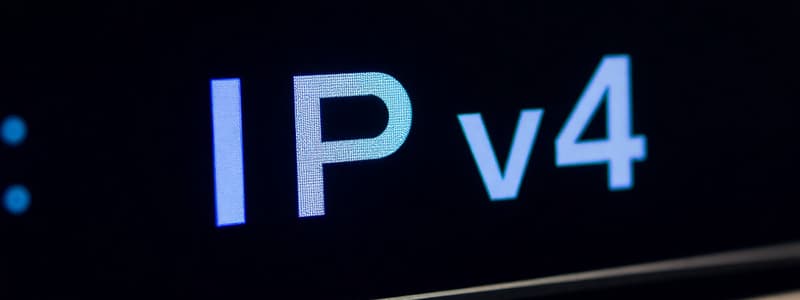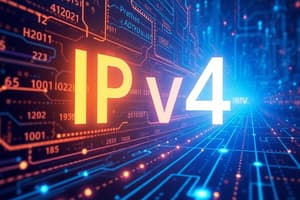Podcast
Questions and Answers
What does the subnet mask determine in an IPv4 address?
What does the subnet mask determine in an IPv4 address?
- The connectivity state of the host
- The class of the address
- The boundary between network and host portions (correct)
- The type of address used
Which IPv4 address type is used for communication from one host to all other hosts on a network?
Which IPv4 address type is used for communication from one host to all other hosts on a network?
- Loopback
- Broadcast (correct)
- Multicast
- Unicast
Which of the following ranges corresponds to a private IPv4 address?
Which of the following ranges corresponds to a private IPv4 address?
- 255.255.255.255
- 192.0.2.0/24
- 169.254.0.0/16
- 172.16.0.0/12 (correct)
What class of IPv4 addresses is designated for large networks?
What class of IPv4 addresses is designated for large networks?
What does CIDR stand for in the context of IP addressing?
What does CIDR stand for in the context of IP addressing?
When converting from binary to decimal, which power of 2 represents the 4th position from the right?
When converting from binary to decimal, which power of 2 represents the 4th position from the right?
Which ICMP tool is primarily used to verify connectivity between hosts?
Which ICMP tool is primarily used to verify connectivity between hosts?
What is the primary purpose of a static IP address?
What is the primary purpose of a static IP address?
In what scenario would a Link-Local address be assigned?
In what scenario would a Link-Local address be assigned?
Which of the following correctly defines multicast addresses in IPv4?
Which of the following correctly defines multicast addresses in IPv4?
IPv4 addresses consist of 16 bits divided into 4 octets.
IPv4 addresses consist of 16 bits divided into 4 octets.
A subnet mask of /24 is equivalent to 255.255.255.0.
A subnet mask of /24 is equivalent to 255.255.255.0.
Public IPv4 addresses are routable on private networks.
Public IPv4 addresses are routable on private networks.
Class B IPv4 addresses are designated for small networks.
Class B IPv4 addresses are designated for small networks.
Link-Local addresses are automatically configured when DHCP fails.
Link-Local addresses are automatically configured when DHCP fails.
CIDR allows the division of a network into smaller segments for optimization.
CIDR allows the division of a network into smaller segments for optimization.
The multicast address range is from 224.0.0.0 to 239.255.255.255.
The multicast address range is from 224.0.0.0 to 239.255.255.255.
The host portion of an IPv4 address identifies the network.
The host portion of an IPv4 address identifies the network.
The decimal number 255 is represented as 11111111 in binary.
The decimal number 255 is represented as 11111111 in binary.
A static IP address is assigned automatically by DHCP.
A static IP address is assigned automatically by DHCP.
Flashcards
IPv4 Address Structure
IPv4 Address Structure
32-bit binary number divided into four octets (e.g., 192.168.1.1), consisting of a network portion and a host portion.
Subnet Mask
Subnet Mask
Determines the boundary between the network and host portions of an IPv4 address, expressed as a CIDR prefix (e.g., /24).
Unicast Address
Unicast Address
A one-to-one communication between two devices using an IP address.
Private IP Address
Private IP Address
Signup and view all the flashcards
Public IP Address
Public IP Address
Signup and view all the flashcards
CIDR
CIDR
Signup and view all the flashcards
ICMP
ICMP
Signup and view all the flashcards
Ping
Ping
Signup and view all the flashcards
Static IP Address
Static IP Address
Signup and view all the flashcards
Dynamic IP Address
Dynamic IP Address
Signup and view all the flashcards
What is an IPv4 address?
What is an IPv4 address?
Signup and view all the flashcards
Network vs. Host Portion
Network vs. Host Portion
Signup and view all the flashcards
Unicast
Unicast
Signup and view all the flashcards
Broadcast
Broadcast
Signup and view all the flashcards
Multicast
Multicast
Signup and view all the flashcards
CIDR (Classless Inter-Domain Routing)
CIDR (Classless Inter-Domain Routing)
Signup and view all the flashcards
Subnetting
Subnetting
Signup and view all the flashcards
Study Notes
IPv4 Addressing Fundamentals
- IPv4 addresses are 32-bit binary numbers organized into four octets, like 192.168.1.1.
- Each address comprises a network portion (identifying the network) and a host portion (identifying the device).
- The subnet mask defines the division between network and host parts. For example, /24 translates to 255.255.255.0.
Address Types
- Unicast: One device sends data to another.
- Broadcast: One device sends data to all devices on the network (e.g., 255.255.255.255).
- Multicast: One device sends data to a specific group of devices (e.g., 224.0.0.0 to 239.255.255.255).
IPv4 Address Categories
- Public Addresses: Used for communication across the internet.
- Private Addresses: Used in internal networks; not routable publicly.
- Ranges include: 10.0.0.0/8, 172.16.0.0/12, 192.168.0.0/16.
- Special Use Addresses:
- Loopback (127.0.0.0/8): For testing local network functions.
- Link-Local (169.254.0.0/16): Automatically assigned when DHCP fails.
- Test-Net (192.0.2.0/24): Reserved for educational purposes.
IPv4 Address Classes (Obsolete, but historically important)
- Class A: Large networks (0.0.0.0 to 127.255.255.255).
- Class B: Medium networks (128.0.0.0 to 191.255.255.255).
- Class C: Small networks (192.0.0.0 to 223.255.255.255).
CIDR and Subnetting
- CIDR (Classless Inter-Domain Routing): Offers a flexible way of defining subnets using prefixes like /20.
- Subnetting: Dividing a larger network into smaller ones to better manage IP addresses.
ICMP and Connectivity Verification
- ICMP (Internet Control Message Protocol): Used for network diagnostics.
- Common ICMP Messages: Used for various diagnostic information, including confirmation of a host, determining that a destination is unreachable, or reporting time-exceeded errors.
- Diagnostic Tools:
- Ping: Checks connectivity to a host.
- Traceroute: Shows the route data packets take and delays along the path.
Number Conversions(Binary and Decimal)
- Binary to Decimal: Calculate each binary bit's value using powers of two.
- Decimal to Binary: Successive subtractions of powers of two.
IPv4 Address Usage
- Static IP: An assigned, unchanging IP address used for servers and printers.
- Dynamic IP: An automatically assigned IP via DHCP, which expires after a period.
Study Focus
- Learn how to determine subnet masks and prefixes.
- Differentiate between private, public, unicast, broadcast, and multicast addresses.
- Use tools like ping and traceroute for network diagnostics.
- Understand how subnetting enhances IP allocation efficiency.
Studying That Suits You
Use AI to generate personalized quizzes and flashcards to suit your learning preferences.




